Calibration of Micro-Parameters of a Mortar Cylinder Specimen under Simple Compression Using a 2D Discrete Element Model
Abstract
:1. Introduction
2. Materials and Methods
2.1. Particle Contact
2.2. Flat Joint Model
2.3. Mortar’s Specimen Description
3. DEM Simulations
4. Experimental Methodology
4.1. Particle Size Distribution: Analysis 1
4.2. Particle Size Distribution Analysis: Analyses 2 and 3
4.3. Parametric Analysis: Analysis 3
5. Results and Discussion
5.1. Particle Size Analysis: Analysis One
5.2. Particle Size Distribution Analysis: Analysis Two
5.3. Parametric Analysis—Analysis Three
6. Conclusions
- The DEM’s stress-strain curves are well-fitted with respect to the experimental data considering different particle size scales. Nonetheless, it is observed more localized concentrations of forces in the DEMs when the particle size scale is smaller;
- There is an increase in and micro-parameters when there is an increment in the particle size scale factor due to the reduction of particle contact area in the specimens;
- The DEM’s stress-strain curve shows a better agreement with the experimental data when increasing the particle size distribution resolution. It is observed more localized concentrations of forces in the DEMs when the particle size distribution resolution is higher;
- The and micro-parameters increment and the decrement when there is a decrement in the particle size distribution resolution. This is due to the decrease in the particle interlocking caused by the reduction of the particle size distribution resolution;
- The ELC micro-parameter increments the macro-Young’s modulus of the DEM. The micro-parameters increment the peak stress. Additionally, the , and micro-parameters increment the hardening section;
- It is recommended that the DEM contains at least two particle sizes to improve the particle interlocking and ensure that the micro-parameters values and the mechanistic behavior represent the experimental observations.
Author Contributions
Funding
Institutional Review Board Statement
Informed Consent Statement
Data Availability Statement
Acknowledgments
Conflicts of Interest
References
- D’Altri, A.M.; Sarhosis, V.; Milani, G.; Rots, J.; Cattari, S.; Lagomarsino, S.; Sacco, E.; Tralli, A.; Castellazzi, G.; de Miranda, S. Modeling Strategies for the Computational Analysis of Unreinforced Masonry Structures: Review and Classification. Arch. Comput. Methods Eng. 2020, 27, 1153–1185. [Google Scholar] [CrossRef]
- Pulatsu, B.; Gonen, S.; Parisi, F.; Erdogmus, E.; Tuncay, K.; Funari, M.F.; Lourenço, P.B. Probabilistic approach to assess URM walls with openings using discrete rigid block analysis (D-RBA). J. Build. Eng. 2022, 61, 105269. [Google Scholar] [CrossRef]
- Albu-Jasim, Q.; Medina-Cetina, Z.; Muliana, A. Calibration of a concrete damage plasticity model used to simulate the material components of unreinforced masonry reinforced concrete infill frames. Mater. Struct. 2022, 55, 36. [Google Scholar] [CrossRef]
- Mohamad, G.; Lourenço, P.B.; Roman, H.R. Mechanics of hollow concrete block masonry prisms under compression: Review and prospects. Cem. Concr. Compos. 2007, 29, 181–192. [Google Scholar] [CrossRef]
- Henrique Nalon, G.; Santos, C.F.R.; Pedroti, L.G.; Ribeiro, J.C.L.; Veríssimo, G.d.S.; Ferreira, F.A. Strength and failure mechanisms of masonry prisms under compression, flexure and shear: Components’ mechanical properties as design constraints. J. Build. Eng. 2020, 28, 101038. [Google Scholar] [CrossRef]
- Pepe, M.; Sangirardi, M.; Reccia, E.; Pingaro, M.; Trovalusci, P.; de Felice, G. Discrete and Continuous Approaches for the Failure Analysis of Masonry Structures Subjected to Settlements. Front. Built Environ. 2020, 6, 43. [Google Scholar] [CrossRef]
- Hrvoje, S.; Nikolić, Z.; Zivaljic, N. A combined finite–discrete numerical model for analysis of masonry structures. Eng. Fract. Mech. 2014, 136, 1–14. [Google Scholar]
- Asteris, P.G.; Plevris, V. Numerical Modeling of Historic Masonry Structures. In Seismic Assessment and Rehabilitation of Historic Structures; IGI Global: Hershey, PA, USA, 2019; pp. 779–795. [Google Scholar] [CrossRef]
- Cundall, P.A.; Strack, O.D.L. A Discrete Numerical Model for Granular Assemblies. Géotechnique 1979, 29, 47–65. [Google Scholar] [CrossRef]
- Sarhosis, V.; De Santis, S.; De Felice, G. A review of experimental investigations and assessment methods for masonry arch bridges. Struct. Infrastruct. Eng. 2016, 12, 1439–1464. [Google Scholar] [CrossRef]
- Ulrich, T.; Negulescu, C.; Ducellier, A. Using the discrete element method to assess the seismic vulnerability of aggregated masonry buildings. Bull. Earthq. Eng. 2015, 13, 3135–3150. [Google Scholar] [CrossRef]
- Dhir, P.K.; Tubaldi, E.; Pantò, B.; Caliò, I. A macro-model for describing the in-plane seismic response of masonry-infilled frames with sliding/flexible joints. Earthq. Eng. Struct. Dyn. 2022, 51, 3022–3044. [Google Scholar] [CrossRef]
- Vadalà, F.; Cusmano, V.; Funari, M.F.; Caliò, I.; Lourenço, P.B. On the use of a mesoscale masonry pattern representation in discrete macro-element approach. J. Build. Eng. 2022, 50, 104182. [Google Scholar] [CrossRef]
- Potyondy, D.O.; Cundall, P.A. A bonded-particle model for rock. Int. J. Rock Mech. Min. Sci. 2004, 41, 1329–1364. [Google Scholar] [CrossRef]
- Potyondy, D.O. A Flat-Jointed Bonded-Particle Material for Hard Rock. In Proceedings of the 46th U.S. Rock Mechanics/Geomechanics Symposium, Chicago, IL, USA, 24–27 June 2012. [Google Scholar]
- Wu, S.; Xu, X. A Study of Three Intrinsic Problems of the Classic Discrete Element Method Using Flat-Joint Model. Rock Mech. Rock Eng. 2016, 49, 1813–1830. [Google Scholar] [CrossRef]
- Castro-Filgueira, U.; Alejano, L.R.; Arzúa, J.; Ivars, D.M. Sensitivity Analysis of the Micro-Parameters Used in a PFC Analysis Towards the Mechanical Properties of Rocks. Procedia Eng. 2017, 191, 488–495. [Google Scholar] [CrossRef]
- Castro-Filgueira, U.; Alejano, L.R.; Ivars, D.M. Particle flow code simulation of intact and fissured granitic rock samples. J. Rock Mech. Geotech. Eng. 2020, 12, 960–974. [Google Scholar] [CrossRef]
- Safranyik, F.; Keppler, I.; Bablena, A. DEM Calibration: A Complex Optimization Problem. In Proceedings of the 2017 International Conference on Control, Artificial Intelligence, Robotics & Optimization (ICCAIRO), Prague, Czech Republic, 20–22 May 2017; pp. 198–201. [Google Scholar]
- Bahaaddini, M.; Sheikhpourkhani, A.M.; Mansouri, H. Flat-joint model to reproduce the mechanical behaviour of intact rocks. Eur. J. Environ. Civ. 2019, 25, 1427–1448. [Google Scholar] [CrossRef]
- Joshi, A. A Discrete Element Study of the Uniaxial Compressive Response of Plain Concrete using the JCFPM Constitutive Model. Ph.D. Thesis, The University of North Carolina at Charlotte, Charlotte, NC, USA, 2018. [Google Scholar]
- Ding, X.; Zhang, L.; Zhu, H.; Zhang, Q. Effect of Model Scale and Particle Size Distribution on PFC3D Simulation Results. Rock Mech. Rock Eng. 2014, 47, 2139–2156. [Google Scholar] [CrossRef]
- Qin, Y.; Liu, C.; Zhang, X.; Wang, X.; Shi, B.; Wang, Y.; Deng, S. A three-dimensional discrete element model of triaxial tests based on a new flexible membrane boundary. Sci. Rep. 2021, 11, 4753. [Google Scholar] [CrossRef]
- Potyondy, D.O. A Flat-Jointed Bonded-Particle Model for Rock. In Proceedings of the 52nd U.S. Rock Mechanics/Geomechanics Symposium, Seattle, WA, USA, 17–20 June 2018. [Google Scholar]
- Boutt, D.; McPherson, B. The Role of Particle Packing in Modeling Rock Mechanical Behavior using Discrete Elements. In Discrete Element Methods; American Society of Civil Engineers: Reston, VA, USA, 2002; pp. 86–92. [Google Scholar] [CrossRef]
- Coetzee, C.J. Calibration of the discrete element method and the effect of particle shape. Powder Technol. 2016, 297, 50–70. [Google Scholar] [CrossRef]
- Coetzee, C.J. Review: Calibration of the discrete element method. Powder Technol. 2017, 310, 104–142. [Google Scholar] [CrossRef]
- C270−19a; Standard Specification for Mortar for Unit Masonry. ASTM: West Conshohocken, PA, USA, 2019. [CrossRef]
- C1006/C1006M−20a; Standard Test Method for Splitting Tensile Strength of Masonry Units. ASTM: West Conshohocken, PA, USA, 2020. [CrossRef]
- Fernandez Baqueiro, L.E.; Hernandez Santillan, J.A.; Varela Rivera, J.L. Comportamiento no lineal de pilas de mampostería de bloques huecos de concreto sujetas a compresión axial. In Proceedings of the Memorias del XX Congreso Nacional de Ingeniería Estructural, Merida, Mexico, 16–19 November 1996. [Google Scholar]
- Wang, P.; Gao, N.; Ji, K.; Stewart, L.; Arson, C. DEM analysis on the role of aggregates on concrete strength. Comput. Geotech. 2020, 119, 103290. [Google Scholar] [CrossRef]
- Watters, M. A Study of the Influence of Particle Gradation in Bonded Assemblies. Bachelor’s Thesis, University of Arkansas, Fayetteville, AR, USA, 2015. [Google Scholar]
- Gyurko, Z.; Borosnyoi, A. Brinell-hardness testing and discrete element modelling of hardened concrete. J. Silic. Based Compos. Mater. 2015, 67, 8–11. [Google Scholar] [CrossRef]
- Jimenez Rios, A. Simulation of Structural Behavior of Masonry Using Discrete Element Modeling. Master’s Thesis, Polytechnic University of Catalonia, Barcelona, Spain, 2016. [Google Scholar]
- Itasca Consulting Group, Inc. PFC Version 5.0 Documentation; Itasca Consulting Group, Inc.: Minneapolis, MN, USA, 2018. [Google Scholar]
- Hernandez Santillan, J. Comportamiento No Lineal de la Mampostería de Bloques Huecos de Concreto Sujeta a Compresión Axial; Universidad Autonoma de Yucatan: Merida, Mexico, 2015. [Google Scholar]
- Doğan, O. An Experimental Study to Determine Sliding Shear Strength and Internal Friction Coefficient of Clay Brick Wall in a Masonry Building. Int. J. Eng. Res 2019, 11, 670–676. [Google Scholar] [CrossRef]
- Gonzalez Torres, V. Determinación de la Resistencia a Compresión Axial de la Mampostería de Bloques de Concreto Usada en Yucatán. Ph.D. Thesis, Universidad Autonoma de Yucatan, Merida, Mexico, 2006. [Google Scholar]
- Bauer, E.; Silva, E.F.d.; Sousa, J.G.G.D.; Salomão, M.C.d.F. Friction Influence between Particles in the Behavior of Flow of Lime-Rendering Mortars. J. Mater. Civ. Eng. 2014, 27, 04014136. [Google Scholar] [CrossRef]
- Cosgrove, K.; Pavía, S. Mechanical and fluid transfer properties of some lime and Portland cement mortars. In Proceedings of the Protection of Historical Buildings, PROHITECH, Rome, Italy, 21–24 June 2009; pp. 1603–1607. [Google Scholar]
- Gulbe, L.; Vitina, I.; Setina, J. The Influence of Cement on Properties of Lime Mortars. Procedia Eng. 2017, 172, 325–332. [Google Scholar] [CrossRef]
- Arandigoyen, M.; Alvarez, J.I. Pore structure and mechanical properties of cement–lime mortars. Cem. Concr. Res. 2007, 37, 767–775. [Google Scholar] [CrossRef]
- Cheung, G.; O’Sullivan, C. Effective simulation of flexible lateral boundaries in two- and three-dimensional DEM simulations. Particuology 2008, 6, 483–500. [Google Scholar] [CrossRef]
- Kazerani, T.; Zhao, J. Micromechanical parameters in bonded particle method for modelling of brittle material failure. Int. J. Numer. Anal. Methods Geomech. 2010, 34, 1877–1895. [Google Scholar] [CrossRef]
- Wang, Z.; Ruiken, A.; Jacobs, F.; Ziegler, M. A new suggestion for determining 2D porosities in DEM studies. Geomech. Eng. 2014, 7, 665–678. [Google Scholar] [CrossRef]
- Zhang, X.-P.; Wong, L.N.Y. Loading rate effects on cracking behavior of flaw-contained specimens under uniaxial compression. Int. J. Fract. 2013, 180, 93–110. [Google Scholar] [CrossRef]
- Coetzee, C.J. Particle upscaling: Calibration and validation of the discrete element method. Powder Technol. 2019, 344, 487–503. [Google Scholar] [CrossRef]
- Newville, M.; Stensitzki Till Allen Daniel, B.; Ingargiola, A. LMFIT: Non-Linear Least-Square Minimization and Curve-Fitting for Python (Version 0.8.0); Zenodo: Honolulu, HI, USA, 2021. [Google Scholar]
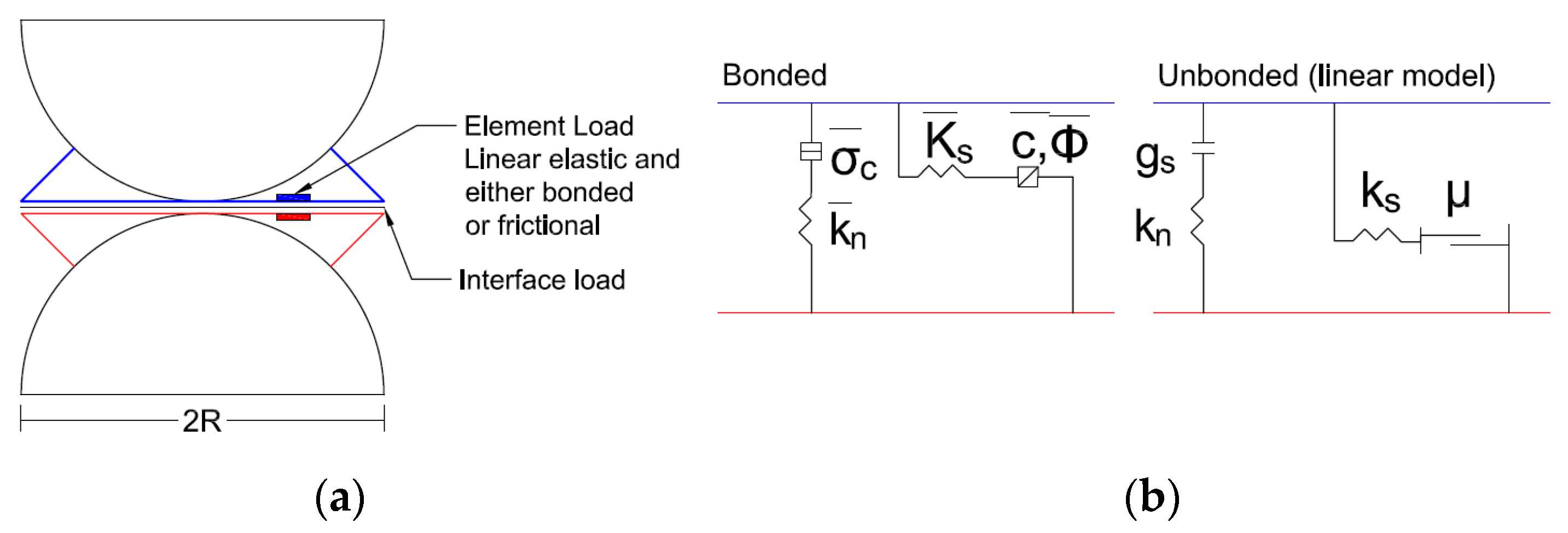
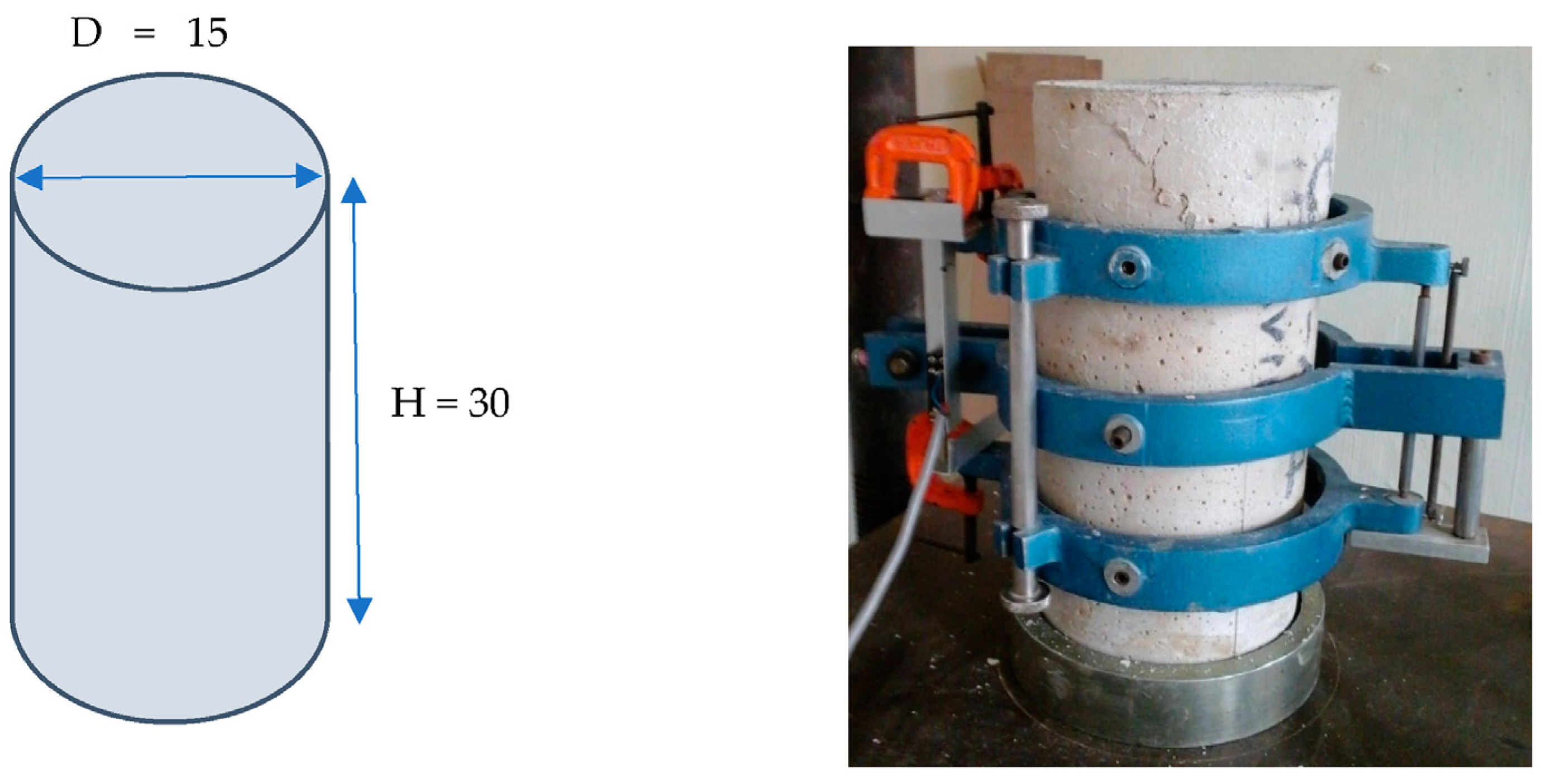

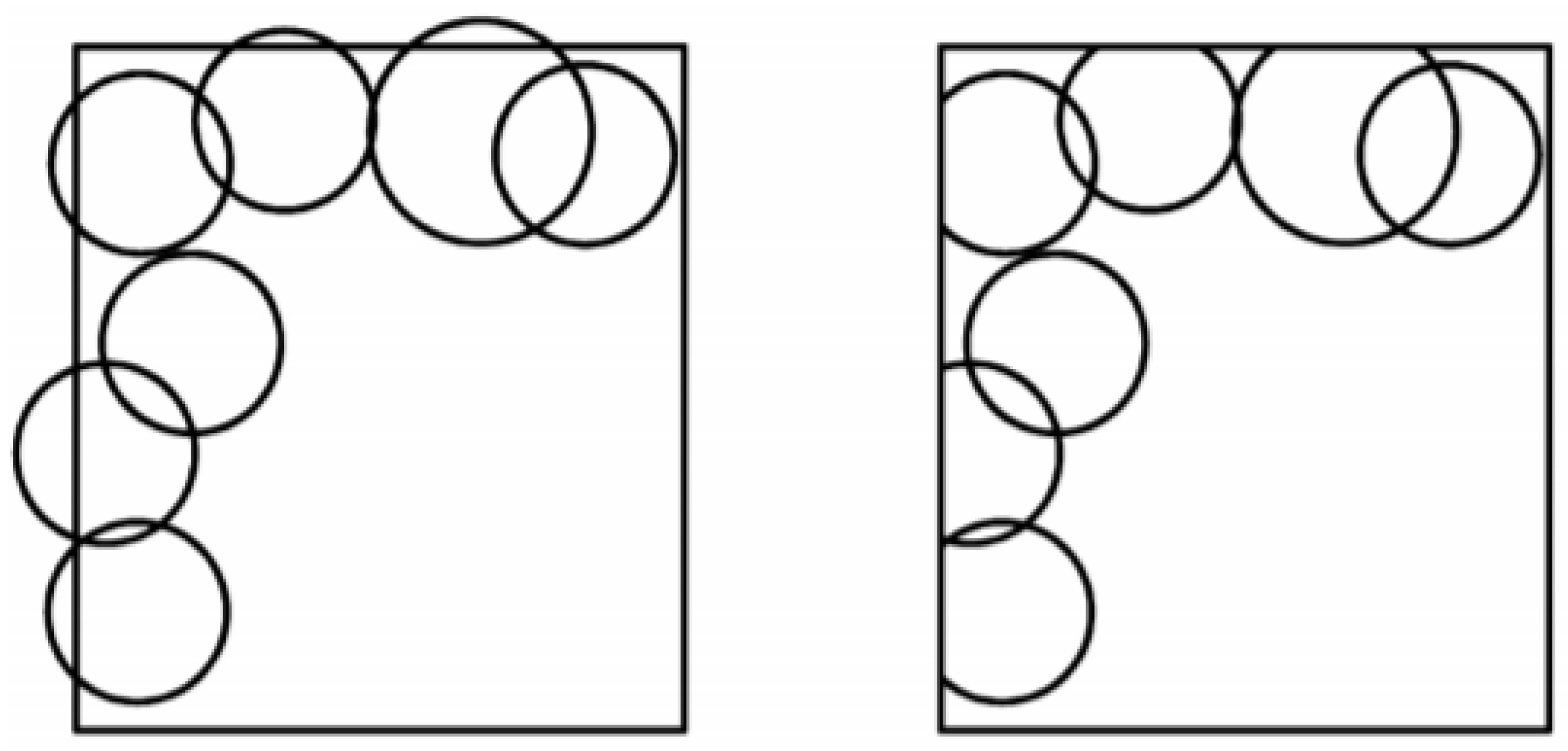
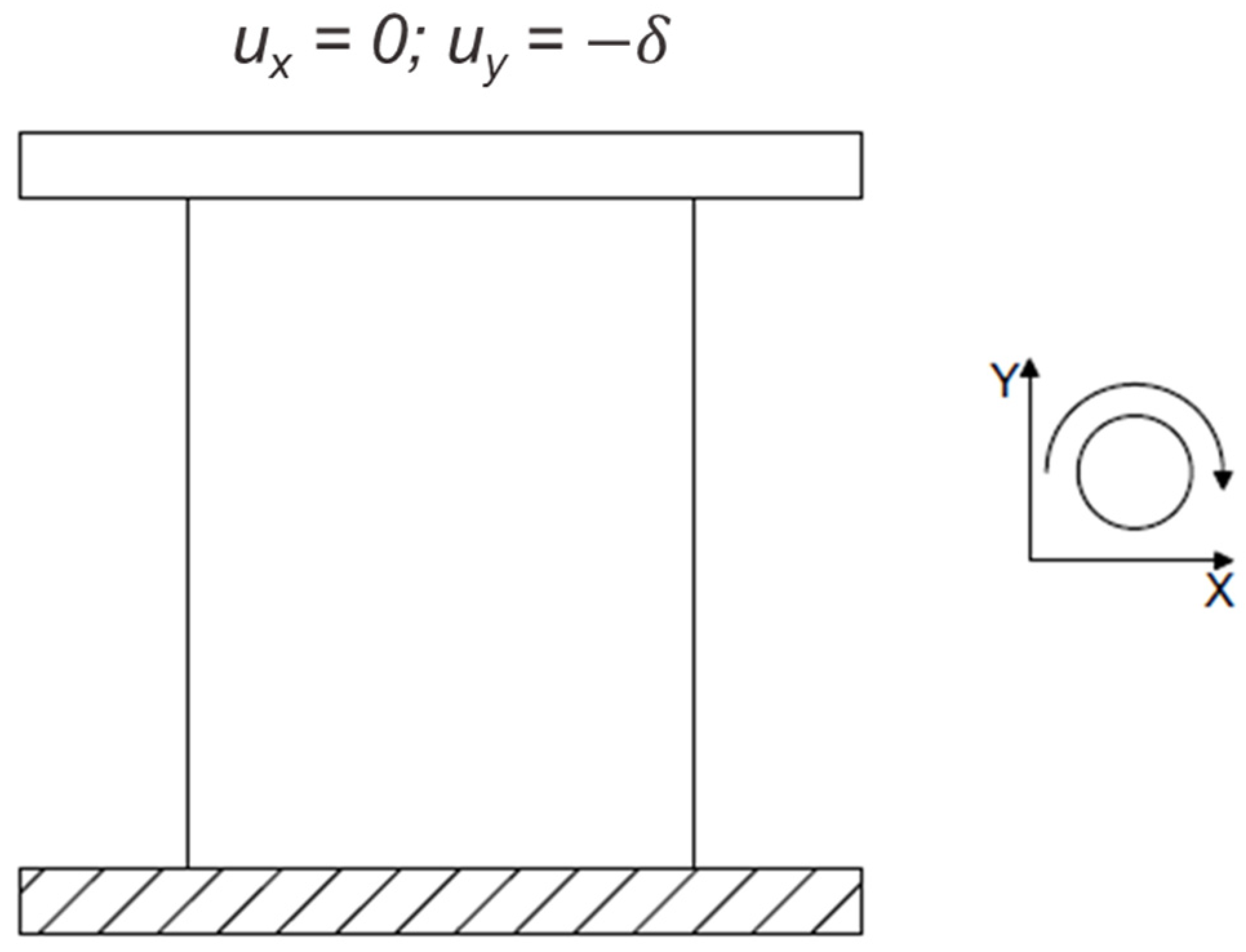


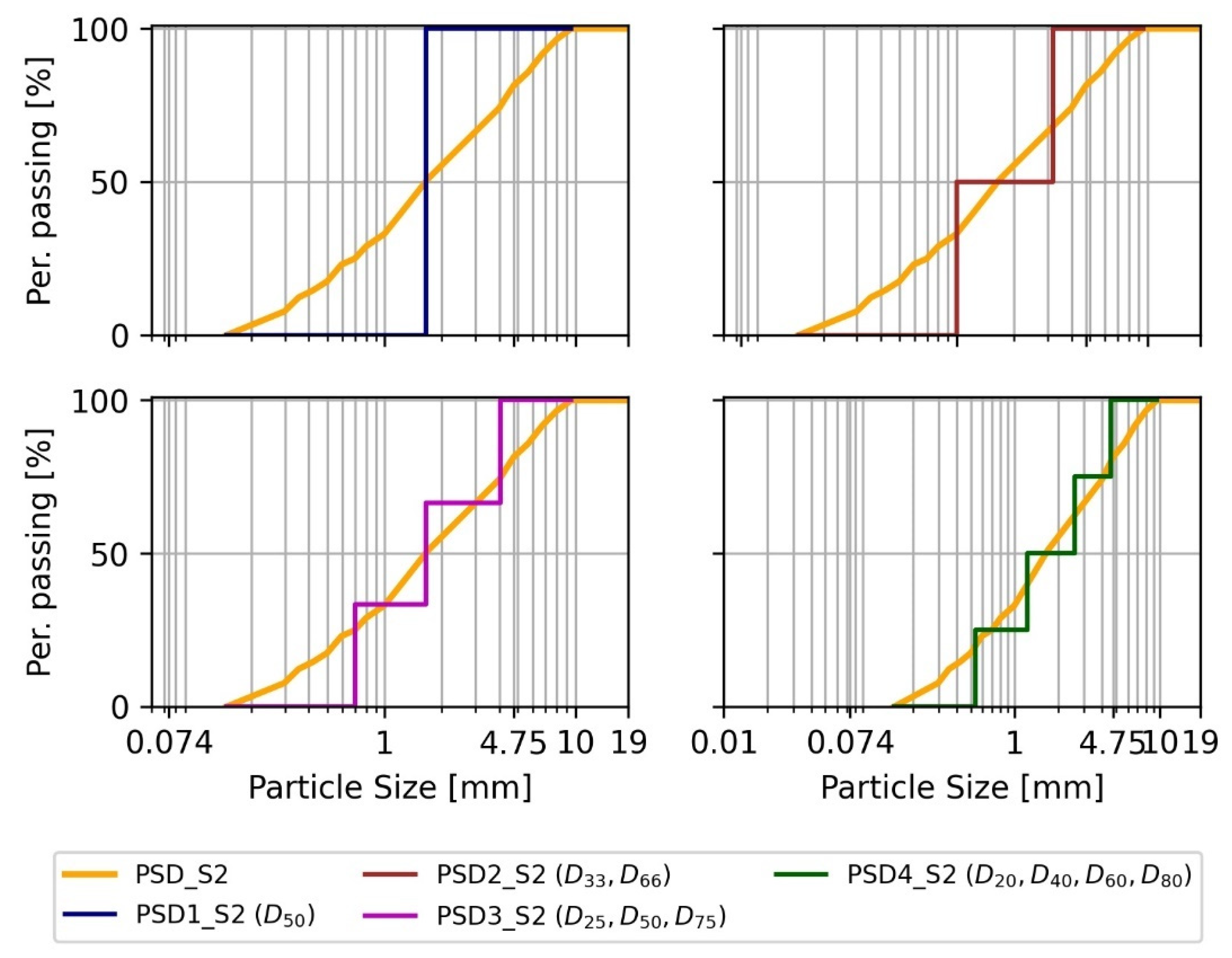
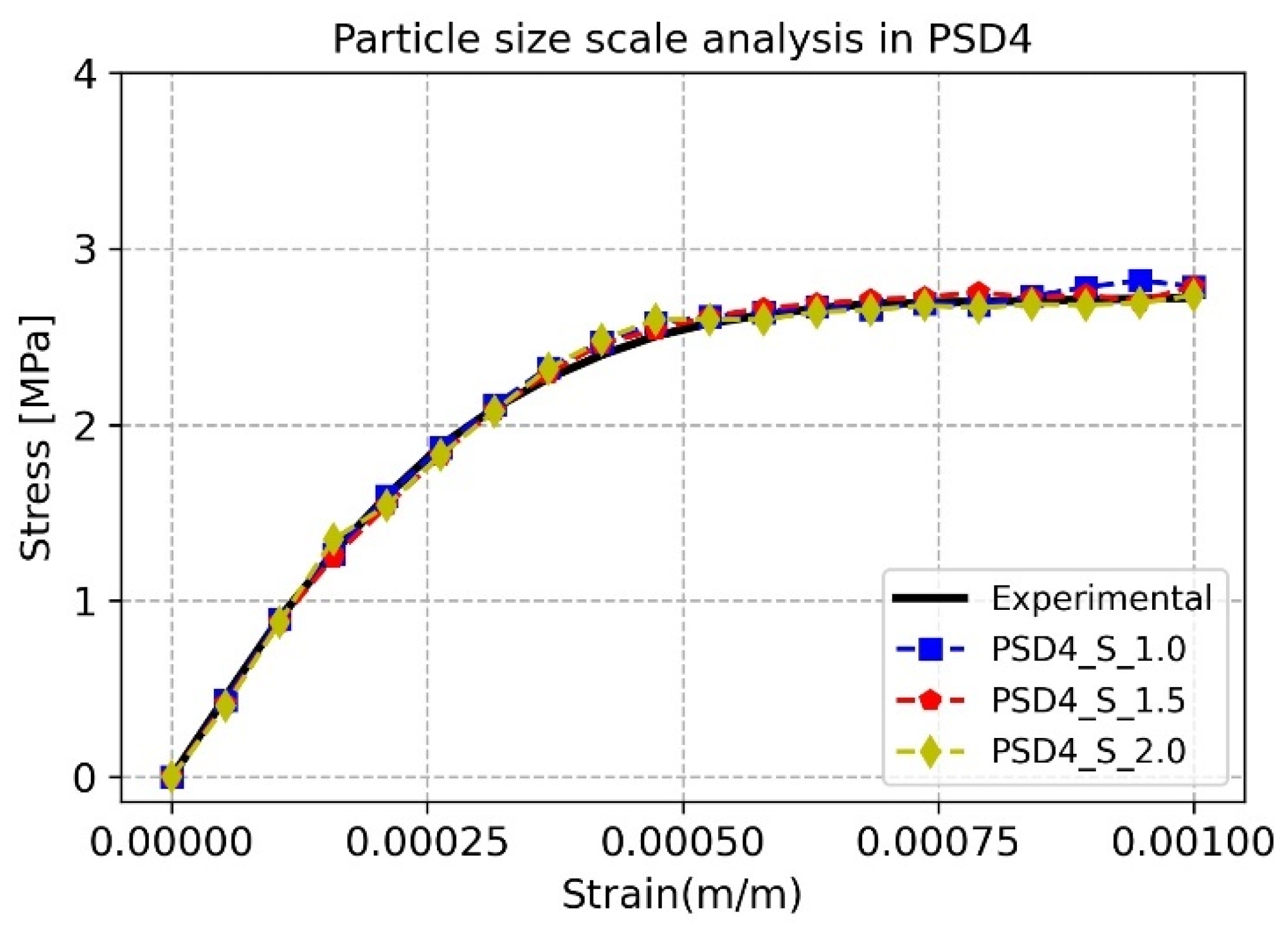
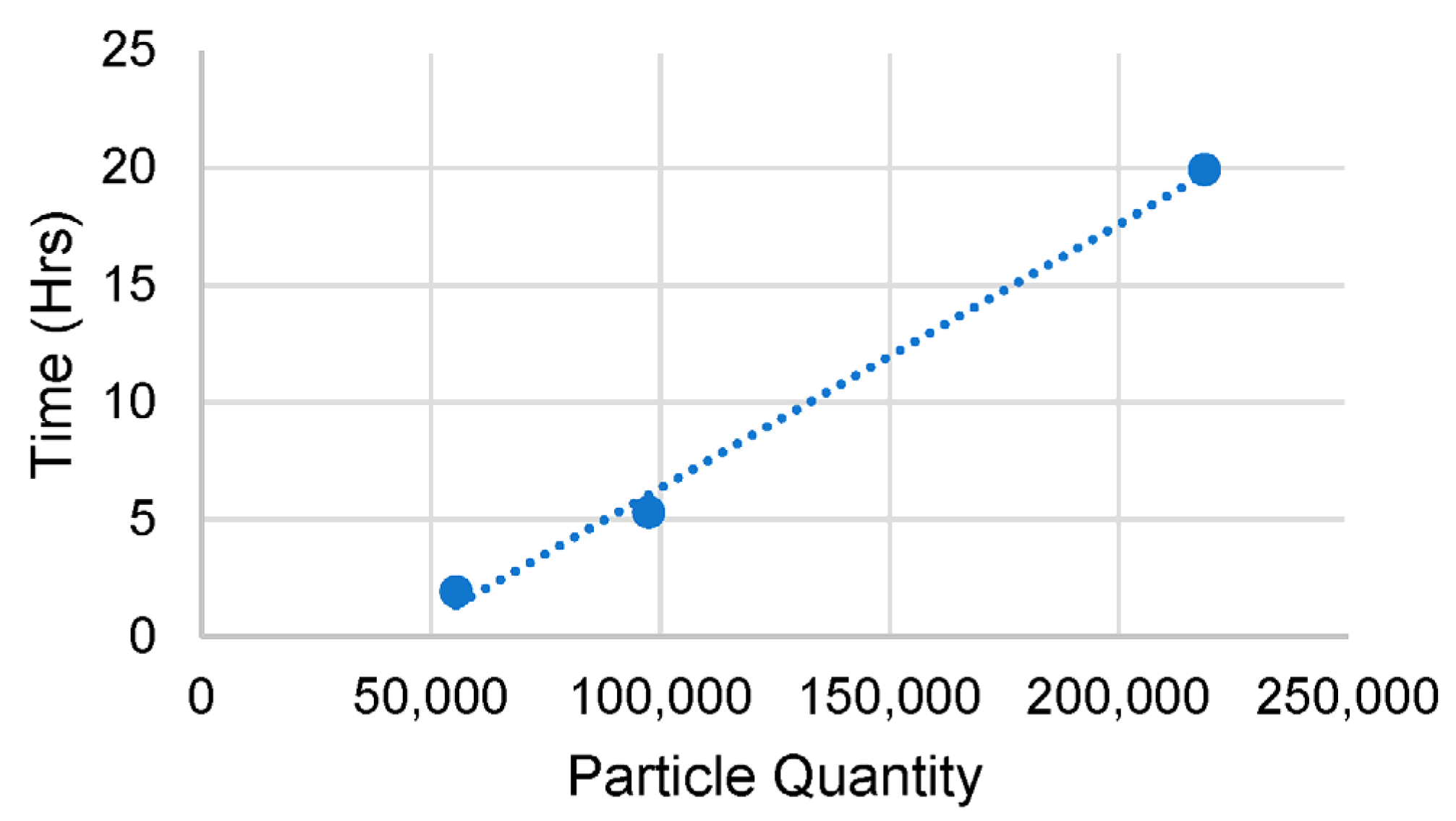

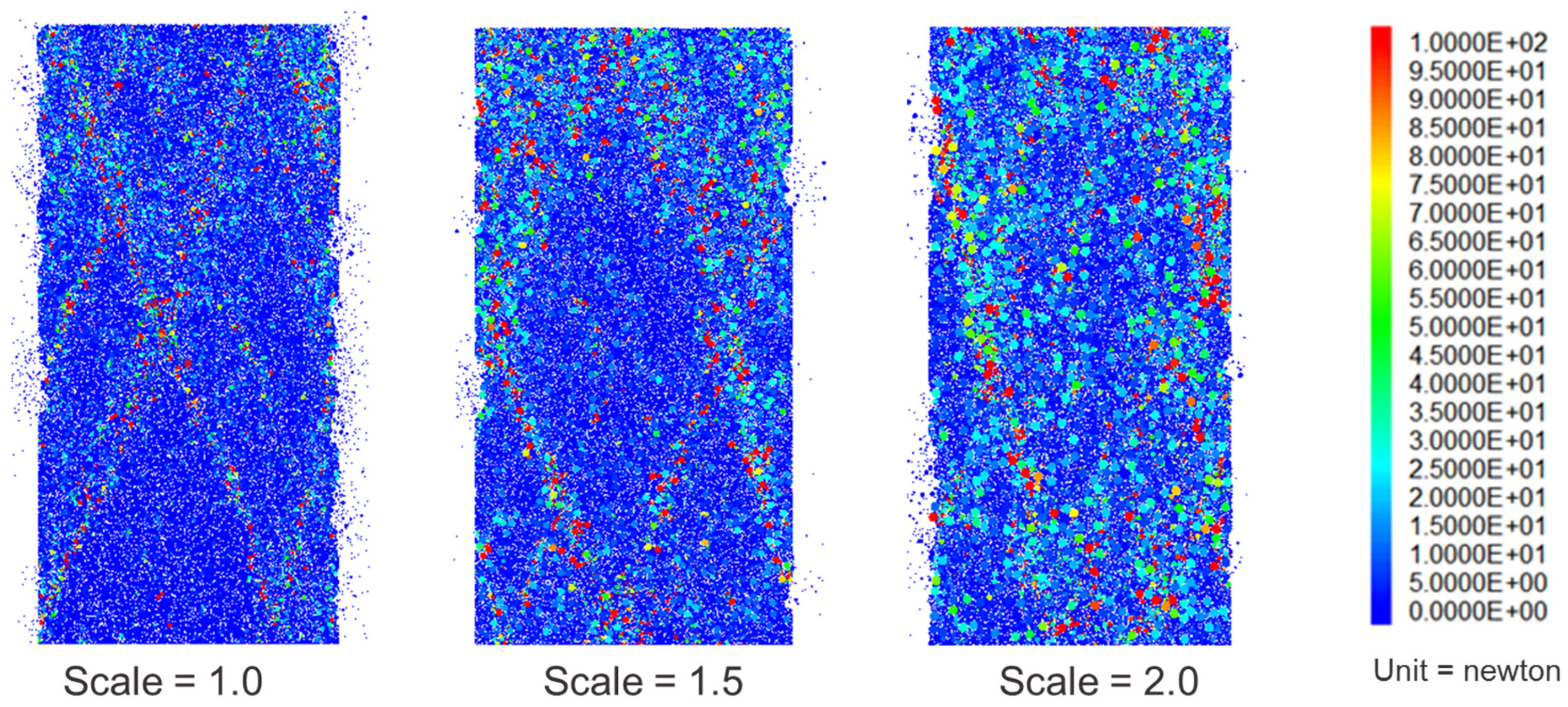
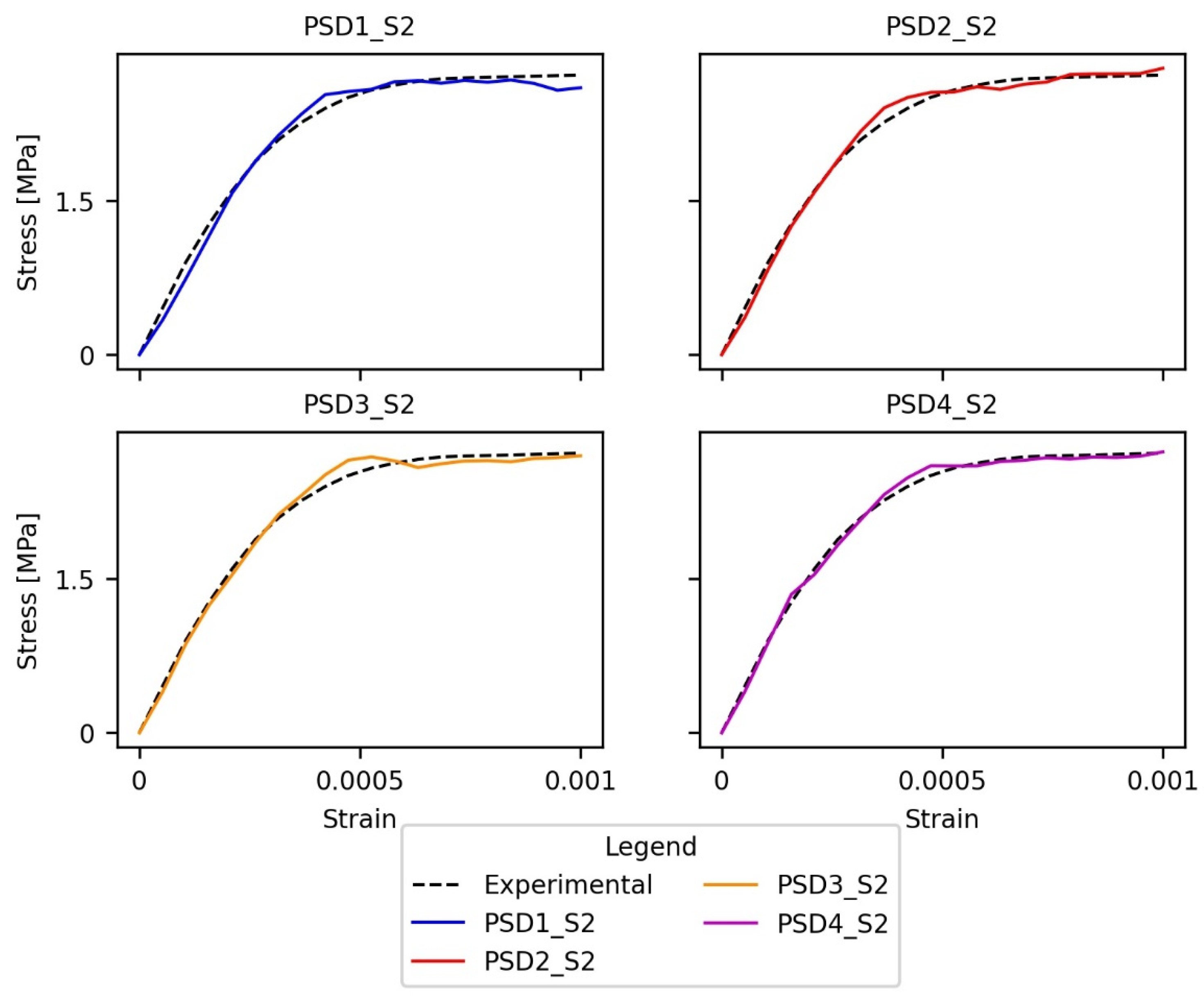
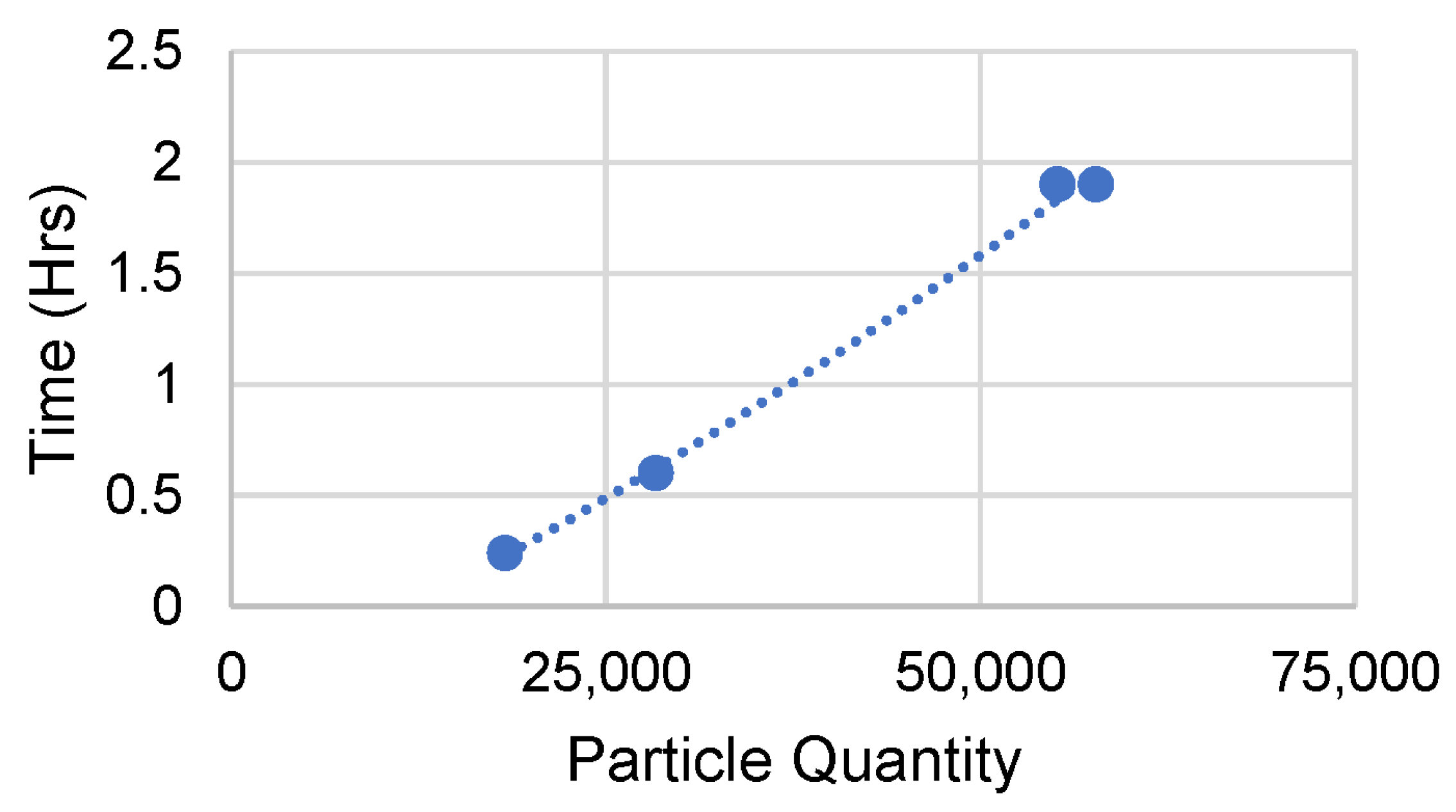


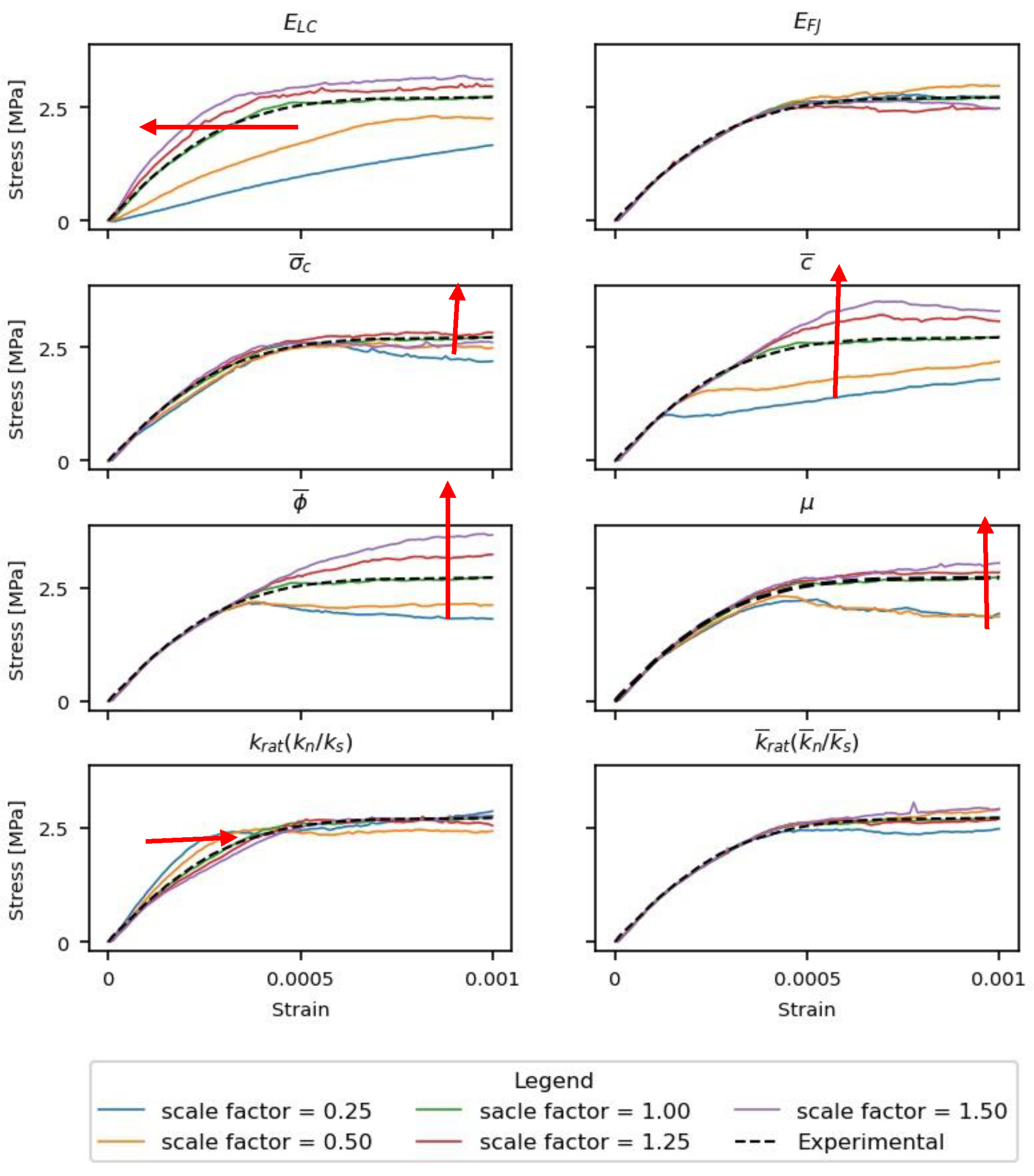
| Parameter | Value | Unit | Source | Type |
|---|---|---|---|---|
| 2.75 | MPa | [36] | Experimental | |
| 0.30 | MPa | [37] | Experimental | |
| 7994 | MPa | [36] | Experimental | |
| 2.5 | Unitless | [38] | Experimental | |
| 34 | Degree | [39] | Experimental | |
| 0.3 | Unitless | [37] | Experimental | |
| 1624 | kg/m3 | [40,41] | Experimental | |
| n% | 22 | % | [42] | Experimental |
| Property | Symbol | Value | Unit |
|---|---|---|---|
| Density | 1624 | kg/m3 | |
| Diameter | – | 4.48–0.54 | mm |
| Young’s modulus | 8.00 | GPa | |
| Stiffness ratio | (/) | 2.5 | Unitless |
| Friction coefficient | 0.10 | Unitless | |
| Porosity | n% | 10 | % |
| Damping ratio | 0.70 | Unitless |
| Property | Symbol | Value | Unit |
|---|---|---|---|
| Density | 1624 | kg/m3 | |
| Diameter | – | 4.48–0.54 | mm |
| Young’s modulus | 8.00 | GPa | |
| Stiffness ratio | (/) | 2.5 | Unitless |
| Friction coefficient | 0.10 | Unitless | |
| Porosity | n | 0.10 | Unitless |
| Damping ratio | 0.70 | Unitless |
| PSD4_S1 | PSD4_S1.5 | PSD4_S2 | ||
|---|---|---|---|---|
| Micro parameters | [GPa] | 7.00 | 7.28 | 7.34 |
| [GPa] | 10.00 | 10.40 | 10.38 | |
| [MPa] | 0.30 | 0.28 | 0.29 | |
| [MPa] | 1.80 | 1.91 | 1.98 | |
| [Coeff.] | 0.13 | 0.15 | 0.21 | |
| [°] | 10.00 | 16.03 | 20.70 | |
| Specimen characteristics | Number of particles | 218,800 | 97,500 | 55,500 |
| CN | 591,398 | 262,291 | 147,235 | |
| FJA [m2] | 94.60 | 62.90 | 47.20 | |
| FJA/CN/1000 [m2/unit] | 0.16 | 0.24 | 0.32 | |
| ST [h] | 19.90 | 5.30 | 1.90 |
| PSD1_S2 | PSD2_S2 | PSD3_S2 | PSD4_S2 | ||
|---|---|---|---|---|---|
| Micro parameters | [GPa] | 5.28 | 6.94 | 7.17 | 7.34 |
| [GPa] | 9.68 | 9.84 | 10.1 | 10.38 | |
| [MPa] | 0.28 | 0.28 | 0.27 | 0.29 | |
| [MPa] | 0.65 | 1.35 | 1.8 | 1.98 | |
| [Coeff.] | 0.41 | 0.28 | 0.21 | 0.21 | |
| [°] | 42.52 | 24.83 | 21.48 | 20.70 | |
| Specimen characteristics | Number of particles | 18,270 | 28,326 | 57,709 | 55,138 |
| CN | 51,906 | 76,522 | 152,812 | 147,235 | |
| FJA [m2] | 43.6 | 40.6 | 49.9 | 47.3 | |
| ST [h] | 0.24 | 0.6 | 1.9 | 1.9 | |
| Drat [m/m] | 1.0 | 3.2 | 5.86 | 8.47 |
Disclaimer/Publisher’s Note: The statements, opinions and data contained in all publications are solely those of the individual author(s) and contributor(s) and not of MDPI and/or the editor(s). MDPI and/or the editor(s) disclaim responsibility for any injury to people or property resulting from any ideas, methods, instructions or products referred to in the content. |
© 2023 by the authors. Licensee MDPI, Basel, Switzerland. This article is an open access article distributed under the terms and conditions of the Creative Commons Attribution (CC BY) license (https://creativecommons.org/licenses/by/4.0/).
Share and Cite
Ortiz-Cahun, M.; Fernandez-Baqueiro, L.; Medina-Cetina, Z. Calibration of Micro-Parameters of a Mortar Cylinder Specimen under Simple Compression Using a 2D Discrete Element Model. Appl. Sci. 2023, 13, 10952. https://doi.org/10.3390/app131910952
Ortiz-Cahun M, Fernandez-Baqueiro L, Medina-Cetina Z. Calibration of Micro-Parameters of a Mortar Cylinder Specimen under Simple Compression Using a 2D Discrete Element Model. Applied Sciences. 2023; 13(19):10952. https://doi.org/10.3390/app131910952
Chicago/Turabian StyleOrtiz-Cahun, Miguel, Luis Fernandez-Baqueiro, and Zenon Medina-Cetina. 2023. "Calibration of Micro-Parameters of a Mortar Cylinder Specimen under Simple Compression Using a 2D Discrete Element Model" Applied Sciences 13, no. 19: 10952. https://doi.org/10.3390/app131910952






